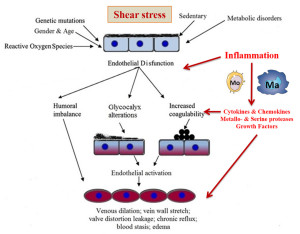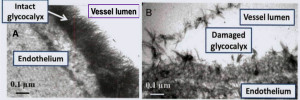Inflammatory biomarkers are molecules detected within the blood or tissues of the patient in response to an insult or injury. In chronic venous disease (CVD) this is an elevated venous pressure from gravitational force. These biomarkers become expressed in inflammation and many are believed to be responsible for the symptoms, pain and skin changes characteristic of CVD. All chronic inflammations express a soup of biomarkers. Some are responsible for on-going damage, a different set may represent healing and repair and others may just be an index of the degree of inflammatory activity. Current research needs to focus on the interaction between the various biomarkers, their profiles and in assessing their role in injury and repair.
LEONARDO ALUIGI Inflammatory processes represent a key role for the onset and the development of CVD. The endothelial cell and its protective coating, the glycocalyx, are the key targets for dysfunction or injury. Monocytes and macrophages produce a complex of cytokines, chemokines, growth factors, proteases and proteinases that are expressed and unbalanced resulting in an environment of persistent inflammation.
A large number of studies have examined over 60 different biomarkers associated with CVD. These include the general biomarkers like fibrinogen, high sensitive C-reactive protein (CPR) and interleukin 6 (Il-6). The following biomarkers are most consistently associated with primary CVD: estradiol, homocysteine and vascular endothelial growth factor (VEGF). The following biomarkers are more specific and have been tentatively associated with symptoms and progression of the disease: interleukin 1-beta (IL-1-beta), IL-8, IL-10, tumour necrosis factor alpha (TNF-a), intercellular adhesion molecule-1 (ICAM-1), vascular cell adhesion molecule-1 (VCAM-1), E-selectin, P-selectin, monocyte chemoattractant-1 (MCP-1), matrix metalloproteinases MMP-1, MMP-2, MMP-3, MMP-9, MMP-13 and their inhibitors (TIMP).
Further studies are required using improved and standardized approaches to better understand and develop inflammatory biomarker research in CVD. This may increase our knowledge on the pathophysiology of CVD and reveal potential therapeutic targets for treatment.
Role of inflammation in the pathophysiology of CVD
Inflammatory biomarkers in CVD
The healthy glycocalyx is seen as a thick tuft protecting the surface of endothelial cells (A). It can be damaged by GAG-degrading enzymes (B).


